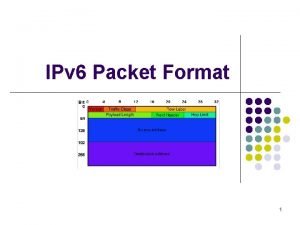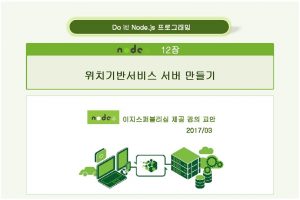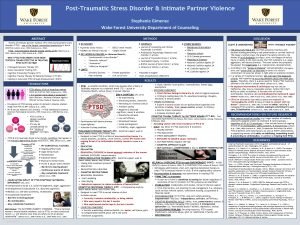Addressing Revictimization Schema in Intimate Partner Violence IPV


























- Slides: 26

Addressing Revictimization Schema in Intimate Partner Violence (IPV) Survivors Linda L. Toche-Manley, Ph. D Polaris Health Directions Diana Bass, MPH UNC Healthcare System (University of North Carolina) George Mc. Clane, MD Independent Forensic Consultant April 2009

Today’s Discussion • Why Assess for IPV? • Review of Polaris Domestic Violence Computer Assessment • Implementation at UNC Healthcare in 5 Different Medical Units • Initial Data on UNC Healthcare Women 1

Why Assess for IPV? • Most common cause of injury in women • 25% lifetime prevalence • Victims access healthcare services more and trust their providers to help them • Documentation can provide legal information for future recourse

Health Effects of IPV • • • Headaches/migraines Musculoskeletal complaints Fatigue/Insomnia Chest pain/palpitations Gastrointestinal disorders Chronic pain Anxiety Eating disorders Substance abuse Sexually transmitted diseases Unwanted pregnancies

Polaris-Domestic Violence • Assists with treatment planning and/or prediction of re-victimization • Provides clinical reports documenting high-risk attitudes, behaviors, and the relational schema that put a woman at risk for violence; • Tracks severity of Post Traumatic Stress Disorder (PTSD), Depression and Anxiety • Tracks mental health changes that impact her readiness to change relational patterns; • Assesses quality of women’s social network; her ability to determine safe/unsafe situations; and abuse schema • Its data can be used to create a case “roadmap” to encourage positive behavior and dialogue between providers

Polaris-Domestic Violence Reports • Indicate whether mental health intervention is warranted; • Include warning flags for whethere is immediate danger from the abuser; • Identify strengths that can be incorporated in the treatment plan; • Indicate the appropriate levels of protection needed for the woman and her family, and the level of services needed with collaborating agencies; • Creates a paper trail if documentation is needed to note the severity and impact of the abuse; • Monitors progress to document long-term recovery when needed 5

Polaris-Domestic Violence: Strength Domains Polaris Domestic Violence Strengths Scales: • Resilience (alpha. 88) • Supports (alpha. 81) • Goal Directiveness (alpha. 84) • Emotional/Relational Skills (alpha. 83) Identifying and supporting strengths to help women recover from abuse. Some examples are: • skills that allow her to determine safe/unsafe persons and situations • key aspects of resilience • the quality of her network • Important emotional/relational skills Polaris DV can measure these changes in wellness.


Polaris-Domestic Violence: Recovery from Abuse Why addressing abuse is so crucial: • Future victimization – reenactment of abuse • Abuse and shame associated with approach-avoidance • Self-silencing/suppression of anger • Other’s needs come first; impacts whether women seek care – especially for chronic conditions • Prevent increasing medical costs • Improve current safety and quality of life

9

100 Emotional Abuse Indicators at Intake Percent 80 60 52 45 40 39 27 21 20 20 0 Felt Unsafe at Home Was Ordered Was Talked to to Do/ Think with Bad Differently Language Had Money Controlled Had Behavior Was Physically Controlled Hurt 10

11

Polaris-Domestic Violence: Symptom Domains Polaris-Domestic Violence Symptom Scales address a woman’s mental health symptoms and needs. It may help women avoid higher healthcare costs due to chronic disease and re-victimization by catching these problems earlier. • PTSD (alpha. 89) • Depression (alpha. 90) • Anxiety (alpha. 86) • Abuse Adjustment (alpha. 92) • BHS (alpha. 93)

13

Current Implementation of Polaris. Domestic Violence Computer Assessment at All Sites Goal of Research Study: • Focus on collection of data to support case planning • Aggregate reporting • Prediction of resilience and revictimization of domestic violence victims

Current Implementation at UNC Healthcare UNC is a public hospital for the citizens of North Carolina. It’s demographics are: • 2/3 of patients are uninsured or Medicaid/Medicare • From rural areas • Lack resources • Have multiple physical and/or mental health problems • Travel significant distances to receive specialized and/or high risk care

Current Implementation at UNC Healthcare Goal: One hundred women at UNC Healthcare in the following areas: Internal Medicine clinics 39% Obstetrical/Gynecological clinics 26% Inpatient Psychiatric Units 16% Chemical Dependency Units 15% Other Inpatient Units 4%

Current Implementation at UNC Healthcare • Nurses screened for abuse per UNC Healthcare policy • Pre-identified as IPV before asked to complete Polaris-Domestic Violence computer assessment • Web-based computer assessment took an average of 15 minutes to complete • Agreed to complete assessments at intake, 90 and 180 days; caseworker assessments at update intervals

UNC Healthcare’s Experience with Polaris. Domestic Violence • It is preferable to do the assessment before seeing the provider • Intake assessment is a snapshot of the woman’s mental health, support systems and resilience • Provides a jumping-off point for the provider to start a conversation about the abuse in the patient’s life • Will be beneficial to the provider and client in a setting where the woman returns on a regular basis

UNC Healthcare’s Experience with Polaris. Domestic Violence • Women did not mind completing the assessment. They hope the doctor will understand DV and its impact on their lives. • Most patients had experienced past abuse. • Can be an emotional experience for the woman. It is preferable to have someone available to talk about the woman’s feelings. • Patients who are poor, older, or have less education (less than 5 th grade) may need assistance in completing the computer assessment.

100 Survivor's Readiness to Change Indicators at Intake 90 Action 84 Percent Agree/Strongly Agree 80 85 75 68 67 60 40 20 0 I talk to others about my relationship I show others I have decided I am doing new I realize that I am doing what abuse is that I deserve to activities for change is up to it takes to be unacceptable be treated well myself me safe from abuse 20

Worse Same Better Change in Strengths: Intake to Most Recent Update 100 Percent 80 60 52 52 43 43 40 33 38 48 38 24 20 10 5 0 Supports Emotional-Relational Skills Goal Directiveness 14 Resiliency 21

100 Worse. Indicators: Same Better. Intake to Most Recent Change in Abuse Schema Update Percent 80 60 40 27 67 60 53 47 20 29 20 20 60 53 27 24 30 20 17 17 20 10 0 I hurt others Abuse happened I blame myself for I should be able It's ok to be People won't like because of abuse because of who I abuse to prevent abused - I'm bad me if they know that was done to am me me Worse. Indicators: Same Better. Intake to Most Recent Change in Abuse Schema Update (continued) 100 67 Percent 80 67 57 60 40 20 17 17 22 11 21 36 21 60 50 14 27 13 0 I deserve to be hurt It's not ok to want things for me I am to blame for abuse in my family I feel shame about who I am 22

100 Worse Symptoms: Same Better Intake to Most Change in Psychiatric Recent Update Percent 80 62 57 60 48 43 60 48 40 40 24 20 0 14 0 BHS 5 Depression 0 Anxiety PTSD 23

Final Thoughts Where the computer assessment would be most valuable: • Lack of clinician time to assess mental health status and impact of abuse • Lack of resources in a setting – No social workers or case managers, for example

Final Thoughts • Helpful to have brochures and/or phone numbers of the DV agencies in the area to accompany the Polaris -DV computer assessment. • Ask for an inservice with your local DV agency so you know what services are offered to women who are receptive to referrals. • Services from DV agencies are helpful for women who have experienced past abuse as well as those currently in an abusive situation. Some may not have fully recovered from abuse if they haven’t had professional counseling.
 The spyware used in intimate partner violence
The spyware used in intimate partner violence Flat addressing vs hierarchical addressing
Flat addressing vs hierarchical addressing Intimate family chapter 2
Intimate family chapter 2 Intimate zone in communication
Intimate zone in communication Intimate family chapter 6
Intimate family chapter 6 Intimacy after incarceration
Intimacy after incarceration Intimate relationships, marriages, and families 9th edition
Intimate relationships, marriages, and families 9th edition Define the relationship chapter 7
Define the relationship chapter 7 Intimate zone in communication
Intimate zone in communication Intimate family chapter 6
Intimate family chapter 6 Frozen register examples
Frozen register examples Meaning of intimate
Meaning of intimate 01 me line intimate
01 me line intimate Intimate antonym
Intimate antonym Meaning of initmacy
Meaning of initmacy Dewgarden foaming intimate wash benefits
Dewgarden foaming intimate wash benefits Define the relationship ch 7
Define the relationship ch 7 Relationship guidelines chapter 8
Relationship guidelines chapter 8 Ipv format
Ipv format Ipv route
Ipv route Route-map ipv
Route-map ipv Portalipv
Portalipv Ipv 4 terdiri dari... *
Ipv 4 terdiri dari... * Ipv 4 terdiri dari... *
Ipv 4 terdiri dari... * 6 packet
6 packet Ipv streaming
Ipv streaming Google analz
Google analz


















































